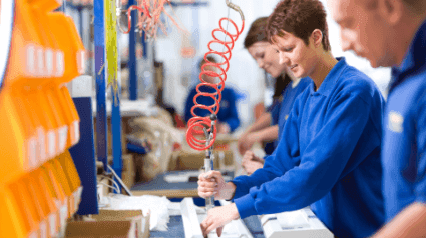What is Chaku Chaku?
Chaku Chaku is a method of conducting a one-piece flow. This method is designed to give workers the shortest possible route from point A to point B, greatly simplifying different processes. Chaku Chaku is under the lean umbrella and is a way to apply Lean practices in a workplace.
An example of Chaku Chaku is having a machine eject a part that it just finished processing. Right after the ejection, another worker takes the finished part and loads it into the next machine for processing until the manufacturing process is complete.
The operator’s main job in the Chaku Chaku process is loading the parts into a machine. The operators are in charge of supplying materials into the machine, taking them after ejection, loading them into the next machine, and continuing the process until they reach their goal.
In Chaku Chaku, workers maintain the machine and not vice versa. It’s very simple and designed to simplify complicated tasks and streamline production.
In traditional manufacturing settings, machines make parts and process materials in batches in different areas of the factory. Whenever a machine finishes a batch of materials, workers must transport it to the next step and load it into the machine again.
With Chaku Chaku, managers put all the machines required to manufacture certain products in one area, called a cell. Additionally, it’s important to automate all manufacturing processes that can be automated to enhance simplicity.
So, after the machine finishes processing one part, the worker simply loads it into the next machine. Chaku Chaku basically means that workers should only be loading products and never unloading them.
Origins
Chaku Chaku is a Japanese term that literally translates to “load load” in English. And in its most basic form, this is all the process is. It only involves workers loading one part into a machine, waiting for it to do its job, and then loading it into the next part.
The Chaku Chaku process was founded on one-piece flow, one of the key manufacturing methods in lean manufacturing. In this process, the goal is to have no “work in progress” (WIP). Operators oversee and monitor a certain batch of materials being produced. Then, they bring that entire finished batch over to the next step of the process.
Benefits
Here are some of the benefits of using the Chaku Chaku method in lean manufacturing:
Moving to One-Piece Flow
Chaku Chaku and one-piece flow go hand in hand. Many manufacturers use a batch-based approach to their work processes. While this may seem simple on the surface, ironing out the logistics of it all is far from it. A much more convenient approach to manufacturing is one-piece flow, where you can remove the concept of WIP.
Instead, everything is completed in the same area. This means workers and teams won’t have to consider transporting parts from one machine to another or figuring out the most efficient way to unload the parts from machines.
With Chaku Chaku, the only time workers unload a product is when it’s finished. Many manufacturers have adopted one-piece flow and Chaku Chaku in manufacturing to simplify the process and improve workplace efficiency.
Simpler Processes
When implementing Chaku Chaku in manufacturing, the main goal is to simplify the process. Eliminating the need to transport batches of parts from different machines and areas of the factor makes it much easier to plan.
Instead of worrying about all the areas in a factory, each product can be placed in a single “cell,” where it undergoes all the manufacturing processes needed for a complete product.
Flexible Operations
Chaku Chaku allows single operators to take charge of multiple processes. This is because overseeing manufacturing isn’t as complicated since managers and operators can focus on singular cells where they can find each step of a product’s manufacturing journey.
Flexibility allows for more efficiency and productivity in the workplace, which is a key benefit of Chaku Chaku.
Understanding the Process
To understand how Chaku Chaku works, it’s best to look at an example. In this example, imagine a lamp manufacturing company. This company started by making each part of the lamp in batches, in separate areas in the factory, and under different operators.
The company followed this model up until they had to start producing many types of lamps. This hurdle made it close to impossible to coordinate the logistics of all the areas in the factory that were working different steps of a singular process.
But by employing Chaku Chaku, they were able to get machines specifically designed to create a certain type of lamp. Then, they placed each of the machines in their own “cell” in the factory. So, cell A had all the machines needed to create lamp #1, while cell B had the machines for lamp #2, and so on.
This process allowed them not just to create more lamps but to do it more efficiently, safely, and productively.
Digitize the way you Work
Empower your team with SafetyCulture to perform checks, train staff, report issues, and automate tasks with our digital platform.
Get Started for FreeTools You Need for Chaku Chaku
Implementing Chaku Chaku in the workplace can be a long process. However, it’s necessary for companies in need of a simpler and more efficient approach to Chaku Chaku. And to properly implement Chaku Chaku in lean manufacturing, you need certain tools. These include:
- Andon lights
- Auto-ejector
- Kanban
- Specialized machines
- Kaizen (to further improve the process)
- Visual management system
Another tool that can help companies implement Chaku Chaku is SafetyCulture (formerly iAuditor). This mobile-first app is designed to increase efficiency and improve manufacturing processes. It also has specific tools managers can use to start using Chaku Chaku in the workplace.




